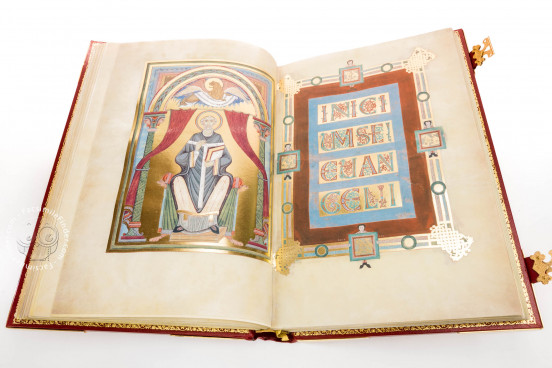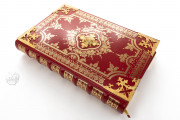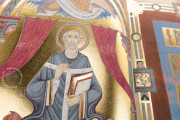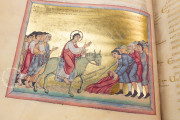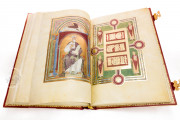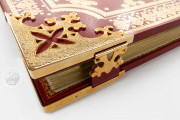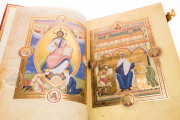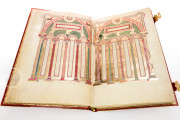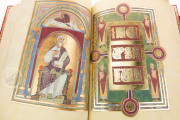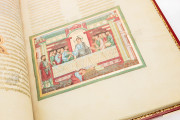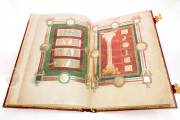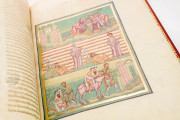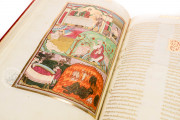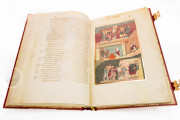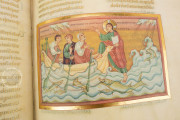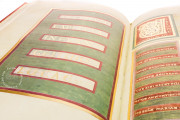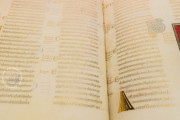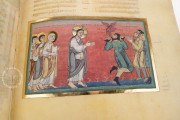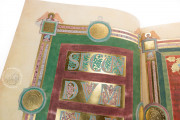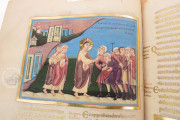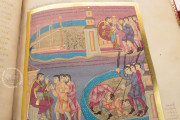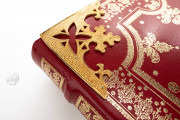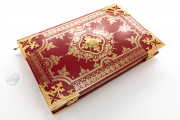Among the grandest imperial commissions to come out of the influential scriptorium of the Echternach abbey, the Speyer Gospels is a splendid example of late Ottonian book manufacture. Also known as the Codex Aureus Escurialensis, the book was commissioned by the Emperor Henry III to commemorate the dedication of the high altar of Speyer Cathedral in 1046. Extensively illuminated with full-page and half-page narrative miniatures, large decorated initials, canon tables, and columnar frameworks, and enhanced with gold and purple throughout, this highly ornate Gospel Book is a conspicuous display of the wealth and prestige of Salian rule.
The scriptorium of the Abbey of Echternach was the main provision of manuscript commissions for the Salian dynasty, and of the surviving examples the Speyer Gospels is the most richly endowed. The book surely earns its modern name, as it contains the complete Latin text of the four Gospels, preceded by prefaces and Eusebian canon tables, written entirely in thick gold ink.
A Masterwork of Late Ottonian Painting
The decorative program consists of thirteen full-page miniatures including a donation image, a Christ in majesty, and portraits of the Four Evangelists; forty-three half-page miniatures illustrating scenes from the New Testament; twelve pages of ornate Canon Tables; forty-four large interlace initials in gold; and display script enriched with gold, silver, and purple ground. Six painters participated in the execution of this ornate program.
With flat colored or gold-leaf backgrounds and sharply contoured statuesque figures, the style is influenced by the prestigious Liuthar School of Reichenau abbey. One of the painters was Byzantine, and his hand is seen in the delicately rendered faces of Christ and Mary and the simulated Eastern silk patterns enlivening the purple pages.
The Wealth of an Empire
Of the splendid Gospel Books produced at Echternach in this time, the Speyer Gospels is the largest and required the slaughter of at least ninety-five calves for their vellum. The text is also materially splendid, written entirely in gold ink in two columns of at most thirty-six lines per page.
The script is Caroline Minuscule and is related to the Echternach Pericopes (Bremen, Universitätsbibliothek, Ms. b. 21) and the Codex Caesareus Upsaliensis (Uppsala, Universitetsbibliotek, C93), also commissioned by Henry III from the scriptorium of Echternach abbey.
A Royal Legacy
The Speyer Gospels was donated to Speyer Cathedral in 1046. By way of inheritance the codex came into the possession of Maximilian I, his daughter Margaret of Austria, and his granddaughter Mary of Hungary.
While in the Netherlands the book was consulted by Erasmus for his editorial work on the New Testament. It was inherited by Philip II, King of Spain, who inserted it into the royal library at the monastery of San Lorenzo de El Escorial.
We have 1 facsimile edition of the manuscript "Speyer Gospels": Códice Áureo facsimile edition, published by Testimonio Compañía Editorial, 1995
Request Info / Price
